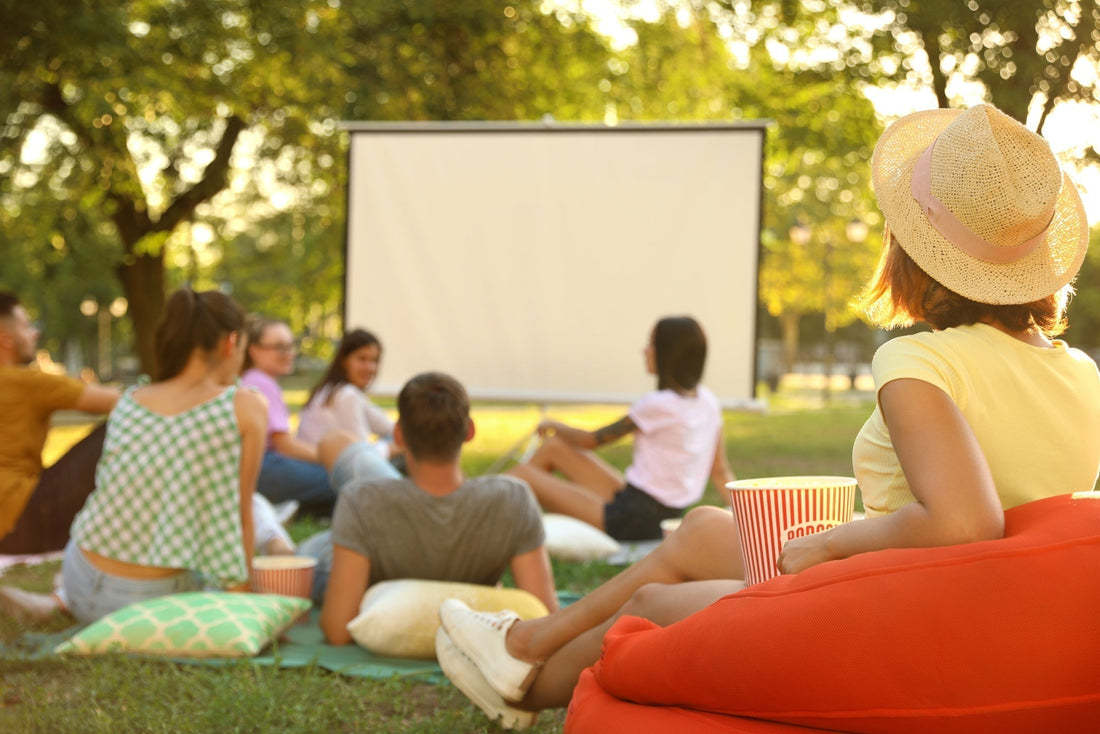
PROJECTORS FOR OUTDOOR DAYLIGHT USE – TIPS FOR A BRILLIANT IMAGE UNDER THE OPEN SKY
Share
 The open-air cinema in your own garden – with a projector, it becomes a highlight, but daylight presents a special challenge.
The open-air cinema in your own garden – with a projector, it becomes a highlight, but daylight presents a special challenge.
For optimal image quality, several factors are crucial – including brightness, the choice of screen, the right placement, and protection against weather conditions.
In this article, you will learn which factors are essential and how to achieve a crystal-clear projection even in daylight.
The challenge: Projectors and daylight
Projectors are primarily designed for use in darkened rooms. Outdoors, the projected image can lose visibility due to bright daylight. The brightness of sunlight far exceeds the luminance of conventional projectors. Therefore, choosing a suitable projector and optimally adjusting the environment is crucial.
Brightness is the key factor
The most important metric for an outdoor projector is brightness, measured in ANSI lumens. The higher the lumen value, the better the image is visible in daylight. As a general rule:
- At least 3,000 ANSI lumens: For good visibility in partial shade or cloudy conditions.
- 5,000 ANSI lumens or more: For a high-contrast and well-visible image even in brighter conditions.
- 10,000 ANSI lumens: If the projector is used directly in a very bright environment.
Even the most powerful projector reaches its limits in direct sunlight. A shaded environment significantly contributes to image quality.
The right screen for outdoor projections
The choice of the right screen plays a decisive role in image quality. A high-quality screen reflects light efficiently and minimizes interference from ambient light. Here are some important aspects:
- Pay attention to the gain factor: The gain value indicates how much light is reflected. A medium gain value of 1.2 to 1.5 improves visibility.
- Light-blocking backside: This prevents light from shining through the screen from behind and affecting the image.
- Textured surface: A textured surface improves image sharpness and reduces unwanted stray light.
- Alternative to screens: If no screen is available, a light, smooth wall can also serve as a projection surface.
Placement and shadow avoidance
The correct positioning of the projector and screen can significantly improve image quality:
- Use shaded locations: A projection surface in the shade offers better contrasts and richer colors.
- Tilt and alignment: The projector should be positioned so that direct sunlight does not outshine the projection.
- Sunshades or pavilions: The use of additional shade providers can help reduce reflections.
Weather resistance and mobility
Projectors are sensitive electronic devices that need protection from moisture, dust, and temperature fluctuations. When used outdoors, the following aspects should be considered:
- Protection from moisture: Waterproof covers or shelters protect against damage from rain or high humidity.
- Dust protection: A clean location prevents dust particles from clogging the ventilation slots.
- Mobility: Compact, battery-powered projectors offer high flexibility and are ideal for mobile use outdoors.
Sound: An often underestimated factor
A brilliant image alone is not enough – good sound is also essential for a true cinema experience. Most built-in projector speakers are too quiet for outdoor use. Recommended options are:
- External speakers: Bluetooth or wired speakers with good sound quality.
- Surround systems: Ideal for an immersive sound experience.
- Consider placement: Speakers should be directed towards the audience to ensure the best sound quality.
For optimal audio transmission, high-quality speaker cables should be used. These ensure minimal signal loss and consistent sound quality – especially for longer cable distances outdoors.
Frequently asked questions about using projectors in daylight
Can you use a projector in daylight?
Yes, it is possible if the conditions are right. A projector with high brightness, a suitable screen, and shaded placement will significantly improve image quality. Direct sunlight should be avoided as even powerful models reach their limits here.
How many lumens does a projector need for daylight?
A projector for outdoor daylight use should have at least 3,000 ANSI lumens to deliver a usable image. For better visibility, 5,000 ANSI lumens or more are recommended. In extremely bright environments, even more powerful devices are required to ensure optimal visibility.
Which projectors are suitable for daylight?
Laser and LED projectors with high light output are particularly suitable for use in daylight. Models with at least 5,000 ANSI lumens provide a good image in most situations. Battery-powered projectors offer additional flexibility as they are independent of a power source.
How do I ensure the best sound for outdoor projections?
Built-in projector speakers are often insufficient for producing clear sound during outdoor projections. External speakers offer the optimal solution to complete the outdoor cinema experience. A high-quality sound system significantly contributes to the atmosphere and ensures that the sound is as impressive as the image. Choose speakers that are loud enough to drown out ambient noise while still providing good sound quality. Additionally, the choice of the right speaker cables plays an important role as they ensure clear signal transmission and optimal sound quality.
Conclusion
A projector can also provide an impressive viewing experience outdoors during daylight if a few important factors are considered. The brightness of the projector is crucial – the higher the lumen value, the better the image visibility. A suitable screen, proper placement, and protection against weather conditions also contribute to optimal image quality. Additional speakers perfectly round off the open-air cinema experience. By following these tips, you can enjoy a brilliant picture under the open sky even in daylight.
